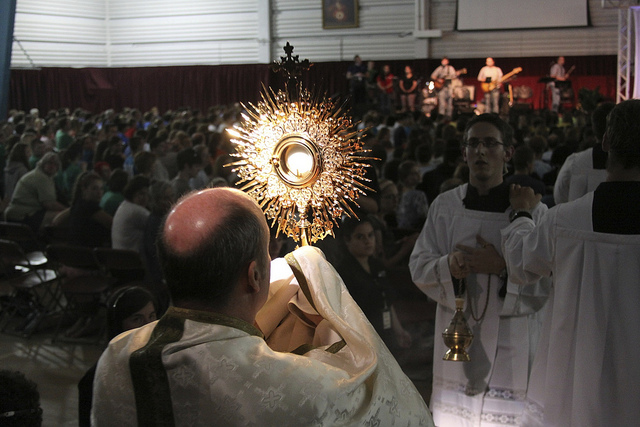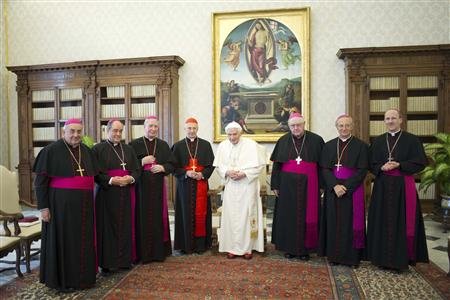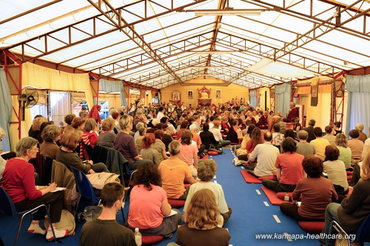Cult of Green:
The United Nations Environmental Sabbath and
the New Global Ethic
By Carl Teichrib (www.forcingchange.org)
NOTE: This essay was first published in Forcing Change back in 2007. It is being reprinted here as an informational/educational service. If you appreciate the depth of research and scope of this essay, please consider an annual subscription/membership to Forcing Change for your subscription support is what enables this research to continue. Go to Apply For Membership and check out the many options available. As a member you will receive each monthly edition of Forcing Change and have access to six years of back issues and reports.
————————-
“Christianity rescued the world from this lunacy. Today, Christian Churches may be in need of rescue.” – Robert A. Sirico.[1]
Environmentalism and religion are indelibly linked. At times this connection is subtle, such as when it’s clothed in the often-bureaucratic language of sustainable development. Other times this marriage is openly acknowledged. The late actor James Coburn, in an Earth Day interview with Caryl Matrisciana at Malibu Beach, enthusiastically proclaimed,

“Mother Earth is the Mother. She’s the Mother Goddess. She’s the one we should be praising rather then raping.
I mean, all of these people here today are here for one reason, because they are concerned about what’s happening to the Earth, what Mankind is doing to the Earth. I mean the negative emotion we carry around a lot of us is another contributor to it. It all feeds the Moon. What we have to do is be true to ourselves, if we are true to ourselves we’ll be true to Mother Earth.
Mother Earth is going to be bountiful. She’ll give us everything we need. She has for a long time.
We’ve lost our way. The pagans used to know how to do it. And the Indians, some of them still remember how to do it.
The Earth is a living organism. We’re killing the one we love the most, and she loves us. We’ve got to praise our Mother Goddess!”[2]
At the world’s political gathering place, the United Nations, eco-spirituality has been embraced in a variety of forms. One example is the UN Convention on Biological Diversity (CBD), a short document hardly amounting to twenty letter-sized pages. Taken at face value, the CBD appears benign in almost every respect, with little in the text that could be construed as religious-in-nature.
Yet when the United Nations Environmental Programme (UNEP) interpreted the CBD, resulting in an oversized  1100+page work titled the Global Biodiversity Assessment, eco-spirituality was included as a global asset. In fact, eco-spirituality was deemed so important that a second massive volume was published, aptly titled Cultural and Spiritual Values of Biodiversity: A Complementary Contribution to the Global Biodiversity Assessment (700+pages on oversized paper).
1100+page work titled the Global Biodiversity Assessment, eco-spirituality was included as a global asset. In fact, eco-spirituality was deemed so important that a second massive volume was published, aptly titled Cultural and Spiritual Values of Biodiversity: A Complementary Contribution to the Global Biodiversity Assessment (700+pages on oversized paper).
So why would the CBD, a minuscule document with no real reference to religion foster such a huge interpretive response, including one text specifically on the spiritual aspects of biodiversity? UNEP published the answer,
“
the UN has turned increasing amounts of time and energy to articulating practical measures for meeting the global environmental crisis and to forming an international consensus around a global environmental ethic. Much of this effort came to fruition at the 1992 Earth Summit through the passage of Agenda 21, the Rio Declaration, and the Convention on Biological Diversity [CBD].”[3]
In case you missed it the answer is found in the middle of the above quote; the formation of “a global environmental ethic.”
Elaborating on this point, J. Baird Callicott, a UNEP contributor and Professor of Philosophy in the Department of Religion Studies at the University of North Texas, writes in Cultural and Spiritual Values of Biodiversity,
“With the current and more ominous global dimension of the twentieth century’s environmental crisis now at the forefront of attention, environmental philosophy must strive to facilitate the emergence of a global environmental consciousness that spans national and cultural boundaries
In part, this requires a more sophisticated cross-cultural comparison of traditional and contemporary concepts of the nature of nature, human nature, and the relationship between people and nature
a new paradigm is emerging that will sooner or later replace the obsolete mechanical world-view and its associated values and technological esprit.
What I envision for the twenty-first century is the emergence of an international environmental ethic based on the theory of evolution, ecology and the new physics
Thus we may have one world-view and one associated environmental ethic corresponding to the contemporary reality that we inhabit one planet
”[4]
According to The Concise Oxford Dictionary, the term “ethic” means “a set of moral principles.” Ethics, and its twin sister, Morality, historically turn on the hinges of religion and philosophical thought. Hence, if a new set of global ethics is to arise, religion as a whole and spiritual leadership in particular must be included in this transformative process. But which religions and spiritual practices are deemed valid in creating a new global, Earth-centric morality?
By seeing which religions are vilified in the United Nation’s system, and by examining which worldview the UN deems important, the answer avails itself. A glimpse of this exists in the two aforementioned CBD interpretive texts. In these volumes Christianity is castigated, while pagan practices and Eastern religions are upheld as positive models.
According to the Global Biodiversity Assessment,
“
the Judaeo-Christian tradition, set humans not as part of a wider community of beings, but apart. It came to view nature as totally dedicated to the fulfilment of human wants, at the pleasure of people. Eastern cultures with religious traditions such as Buddhism, Jainism and Hinduism did not depart as dramatically from the perspective of humans as members of a  community of beings including other living and non-living elements. So Hindus continue to protect primates
Buddhist shrines in southeast Asia have temple groves attached to them, as do Shinto shrines in Japan. This does not at all mean, however, that these Asian societies have not permitted large-scale erosion of their biological diversity, whether in India or Thailand.
community of beings including other living and non-living elements. So Hindus continue to protect primates
Buddhist shrines in southeast Asia have temple groves attached to them, as do Shinto shrines in Japan. This does not at all mean, however, that these Asian societies have not permitted large-scale erosion of their biological diversity, whether in India or Thailand.
Societies dominated by Islam, and especially by Christianity, have gone farthest in setting humans apart from nature and in embracing a value system that has converted the world into a warehouse of commodities for human enjoyment. In the process, not only has nature lost its sacred qualities, but most animal species that that have a positive symbolic value in other human cultures have acquired very negative connotations in the European culture. Conversion to Christianity has meant an abandonment of an affinity with the natural world for many forest dwellers, peasants, fishers all over the world.”[5]
After laying basic blame for environmental problems at the feet of Christianity, the Assessment continued its chastisement by giving the negative example of sacred grove destruction.
“The northeastern hill states of India bordering China and Myanmar supported small scale, largely autonomous shifting cultivator societies until the 1950s. These people followed their own religious traditions which included setting apart between 10 and 30% of the landscape as sacred groves and ponds. Most of these people were drawn into the larger market economy and converted to Christianity by the late 1950s. On so converting to a religious belief system that rejects assignment of sacred qualities to elements of nature, they began to cut down the sacred groves
”[6]
The second UNEP interpretive volume, Cultural and Spiritual Values of Biodiversity, takes an even more challenging approach to Christianity and Western positions. It proposes that world religions, “especially those in the West,” redefine their ultimate purpose to align with a more radical Earth view; suggesting that Western religions compare their cosmology with the Assisi Declarations,[7] which propagates world unity and universal harmony as the answer to Mankind’s globally destructive tendencies.[8]
Moreover, the “Christian philosophy of the white man” is referred to as “the ego-driven hegemony of Christian doctrine.”[9] Instead of these negative “white man” philosophies, other more harmonious world-views are to be encouraged, such as the sacredness of the soil: “The soil is our Goddess; it is our religion.”[10]
Eco-feminism, antagonistic to Christianity and the image of “God as single, male and transcendent,”[11] is also brought to the forefront. The UNEP contributor on eco-feminism suggests a number of “interconnected transformations of our world-view.”
- “A shift from a conception of God as holding all sovereign power outside of and ruling over nature; to a conception
 of God who is under and around all things, sustaining and renewing nature and humanity together as one creational biotic community.”
of God who is under and around all things, sustaining and renewing nature and humanity together as one creational biotic community.”
- “A shift
to a view of the world as an organic living whole, manifesting energy, spirit, agency and creativity.”
- “A shift from an ethic that non-human entities on the earth, such as animals, plants, minerals, water, air and soil have only utilitarian use value
to a view of all things having intrinsic value to be respected and celebrated for their own being.”
- “A shift
to a holistic psychology that recognizes ourselves as psychospiritual-physical wholes in interrelation with the rest of nature as also psychospiritual-physical wholes who are to mutually interdepend in one community of life.”
- “A shift from a view that patriarchal dominance is the order of ‘nature’
to a recognition that patriarchal dominance is the root of distorted relations
”
- “A shift from the concept of one superior culture (white Western Christian) to be imposed on all other peoples to
 ‘save’ and civilize’ them; to a respect for the diversity of human cultures in dialogue and mutual learning, overcoming racist hierarchy and defending particularly the bioregional indigenous cultures which are on the verge of extinction.”
‘save’ and civilize’ them; to a respect for the diversity of human cultures in dialogue and mutual learning, overcoming racist hierarchy and defending particularly the bioregional indigenous cultures which are on the verge of extinction.”
- “A shift from a politics of survival of the fittest that allocate resources and power to the most powerful; to a political community based on participatory democracy, community-based decision-making and representation of the welfare of the whole bio-region in making decisions.”[12]
Fitting with these alternative views, Cultural and Spiritual Values of Biodiversity presents the Gaia idea as a cornerstone paradigm. This “scientifically” favored hypothesis entwines various co-evolutionary and Mother Goddess concepts around a self-organizing Earth principle,[13] forming a united foundation to serve the call of planetary interdependence. Conversely, in reference to the Judeo-Christian order of nature as found in the first chapter of Genesis, the UNEP volume contends that “a culture built on ‘domination of the earth, and the animals therein’ is doomed to disappear.”
So it’s no surprise to read,
“
primitive religions and cultures, often conceived of as constituting one single and earliest form of religion, have constantly functioned as the positive or negative counterpart to Western civilization and life. In the period of environmentalism they have predominately functioned as positive, sometimes even paradisiacal, models for an ecologically sound world-view and society. The period of environmentalism coincides with a period of New Age thinking
”[14]
Obviously the religious foundation for the coming global ethic, which is designed to save the planet from calamity, must be built on pagan/Eastern cosmologies. Christianity maligned with its Western consumption and development patterns, it’s dominance over gender and nature, and its racially “superior” cultural mindset must “disappear.”
But “Christianity,” or a form of it, can have its place at the international table. In a metaphorical way a spot for it has been set, along with place mats for the other monotheistic faiths. However two unspoken, simple requirements first need to be met.
First, abandon the fundamentalist aspects of the Biblical faith, rife with its talk of sin and salvation, and reject the exclusiveness of Jesus Christ which separates and divides. And secondly, join the world in re-forging society so that the Brotherhood of Man and the Fatherhood of God prevails. In other words, turn your back on the narrow, foundational tenants of the Bible and partner to create a unified world, recognizing that all religions are valid expressions of the Living Cosmos. And it doesn’t really matter what order this is done in, as long as the end result of a new global ethics is attained.
And to make sure that the place at the table is filled, assistance from the international community is available.
For almost forty years UNEP has sponsored the World Environment Day (WED). Each June 5th, a host city sponsors the WED with a specific environmental theme. This year (2007) the host city was Tromsø, Norway, with the theme: “Melting Ice A Hot Topic?”

Other themes have included, “Give Earth a Chance” (2002), “We the Peoples: United for the Global Environment” (1995), and “Only One Earth, Care and Share” (1992). Cities that have hosted the event include San Francisco (2005), Moscow (1998), and Nairobi (1987), among others (see the sidebar “World Environment Day: Hosts and Themes” at the end of this article).
It’s in this context of the World Environment Day that the UN Environmental Sabbath was launched, specifically designed to fall on the weekend closest to the WED. As one writer for the Earth Island Institute noted, “The approach of World Environment Day also signals the return of another unique UN-conceived event the Earth Sabbath a day of worship that transcends denominations and welcomes all faiths to participate in a day of global reverence for the Earth.”[15]
Leigh Eric Schmidt, writing for The Harvard Theological Review in 1991, provides some of the historical details of this unique, annual Earth worship event.
“The first Earth Day in 1970 provided an occasion within the churches for expressing concerns over the environmental crisis. Religious involvement in this ecological awakening was substantial. Both the president and the general secretary of the National Council of Churches endorsed Earth Day in mailings to church leaders in March 1970; they also encouraged the observance of an Environmental Sabbath the weekend before
Despite the call in 1970 for an Environmental Sabbath, the idea did not develop until the United Nations Environment Programme appropriated it in 1986, linking it with World Environment Day
Interreligious in its construction, the Environmental Sabbath is intended to be a time ‘to contemplate our bond with nature’ and to cultivate ‘a more caring, knowing and responsible attitude toward our use of Earth’s gifts.’ With an estimated ‘25,000 groups of celebrants’ in 1990 in churches, synagogues, colleges, and youth organizations the Environmental Sabbath is explicitly liturgical and religious in its inspiration (in contrast to the more politically oriented activities of Earth Day)
”[16]
Although UNEP adopted the Sabbath in 1986, it wasn’t until the following year that the program went public. According to John J. Kirk, co-founder of the Interfaith Partnership for the Environment, an organization established by UNEP in to work on the Sabbath, the target audience was initially North American churches.
“It began in the fall of 1986 when a few of us met at UN headquarters in New York with leaders of several faith communities. With guidance and support from the United Nations Environment Programme, we began developing a project that would inform North American congregations about the serious environmental problems facing life on Earth, so we could work to protect this magnificent work of the Creator.
In June of 1987, our first Environmental Sabbath kit went to congregations across the United States and Canada. The goal was to create a sabbatical for our beleaguered planet an Earth Rest Day to be celebrated annually by faith communities
”[17]
Noel J. Brown, the UNEP Director during the 1990 Earth Sabbath, presents us with deeper reasons then just informing North American congregations. In a letter dated March 28, 1990, Brown wrote,
“Once again, the United Nations Environmental Programme (UNEP) is pleased to invite you to join us in celebrating the ‘Environmental Sabbath/Earth Rest Day’ in your ceremonies, rituals and prayers
The need for establishing a new spiritual and ethical basis for human activities on Earth has never been greater as the deterioration of our Planetary Home makes the protection of the human environment a new global imperative.”[18]
Less then six months before his letter went public, Brown was candidly seeking the complicity of religious leaders in his quest to create a new global ethic. Consider these statements made while the UNEP Director was visiting the Los Angeles Interfaith Council,
“Now we need to work more closely with the religious and spiritual community. We need to create an ecumenical movement I call it an ‘eco-menical’ movement in the service of the Earth. It’s time for us to think again, and to think anew
We would also like to suggest other challenges that you in the religion and faith community might help us with. The first is a new vision, and supporting institutions, to help us move through this transition. We in the United Nations cannot hope to solve the problems of the future with only the institutions and the mentality of the past. We need a vision that encompasses all human rights to freedom, equality and conditions of life; and an environment that promises life, dignity and well-being. We need also a new legitimacy, a new ethic, and new metaphors.
we must create a new vision and an institution that can help us to deal with these new realities.
One of the new metaphors that I am eager to produce and promote is that of a covenant a new covenant with the Earth. You in the religious communities can help us do that
That is the challenge facing all of us, and that is the challenge to which I ask you to work with us as allies. We can create a new order, and if we are to survive, indeed we must.”[19] [Italics in original]
At the time of the 1990 event, Christian denominations sitting on the Environmental Sabbath interfaith board included the American Baptist Church, the Protestant Episcopal Church, the United Methodist Church, and the United Church of Christ.[20] Moreover, a special Earth worship resource book was prepared by UNEP for the Sabbath, suitably titled Only One Earth.
Focusing on changing the current religious paradigm towards a new ecological way of thinking, Only One Earth was a source book filled with meditative readings, prayers, and songs for congregational use. Even worship service suggestions were included, such as the excerpted recommendations listed below.
The Sermon:
- “Describe the crisis. Use scientific data. Highlight the urgency of the situation.”
- “Speak of the essential earth-human relationship. What is it? What is our responsibility to it?”
- “Point to various sources of inspiration: to scripture, to wisdom and spirituality; and to the Earth itself. Show how they are all important, and tied together.”
The Service:

- “Decorate your sanctuary with photographs of the Earth as seen from outer space, and with other Earth images.”
- “Invite guest speakers or ‘representatives’ from other species, i.e. plants and animals.”
Go Further:
- “In regular services, insert a portion that focuses on reverence and care for the Earth.”
- “Organize an interfaith ceremony.”
- “Organize an Environmental Sabbath concert or festival
”
- “Write letters to the national and regional leaders of your faith, encouraging them to take action.”[21]
For religious leaders who were so inclined, churches could participate through a variety of listed meditations and reflections. Hindu, Buddhist, Judaic, North American Indian, Islamic, and Christian prayers were suggested; all with an Earth-centric and/or mystical tone. Topping it off, at the back of the UNEP Sabbath worship book was the Earth Covenant, a type of “citizens’ treaty” that could be copied and distributed to the worshipers (see “Earth Covenant” sidebar).
The response to the Environmental Sabbath of 1990, the kick-off year of Only One Earth, was noteworthy. Not only did many churches and groups embark on this Earth-first journey, estimated at 25,000 by Leigh Eric Schmidt, it added real momentum towards acceptance of an environmental theology. And over the years, the program, according to John Kirk, has spawned “more than 130,000 religion and ecology projects
worldwide.”[22]
Granted, the Environmental Sabbath never reached the tremendous general popularity held by the April 22nd Earth Day. But it wasn’t designed for the general public. Rather, the Environmental Sabbath program was target specific: religions and spiritual leaders, churches, and entire denominations.
In the year 2000, Only One Earth was revamped and re-released as Only One Earth: A Book of Reflection for Action. On page 3 of this new and enlarged edition, UN Under-Secretary-General Klaus Töpfer offered some words of eco-wisdom,
“We have entered a new age. An age where all of us will have to sign a new compact with our environment
and enter into the larger community of all living beings. A new sense of our communion with planet Earth must enter our minds.”[23]
Today, New Age eco-spirituality is sweeping through the Christian community, influencing para-church organizations, local congregations, and up into the leadership of entire denominations. If one where to catalogue the situation only in North America, it would take an entire book to list all the ministries and churches that have adopted this ideology either by naivety or by consent.
Seeing the handwriting on the wall, Robert A. Sirico, president of the Acton Institute, penned these words regarding the Earth Sabbath, paganism, and the embracement of these ideas by religious leaders.
“Consider the ‘confession’ of environmental sins offered by the National Council of Churches (NCC): ‘We are responsible for massive pollution of earth, water and sky
We are killing the skies: as the global atmosphere heats up from chemical gases, as the ozone layer is destroyed.’
Scientists say most of these concerns are overblown. But let’s just say these assertions are true. At most, they are technical matters to be addressed by specialists in the public or private sector. They shouldn’t have far-reaching spiritual relevance. No one is in Hell for using aerosol hairspray.
Only if we jettison traditional teachings can we agree with the words of NCC’s eco-celebrant, who says in one proposed prayer: ‘We must say, do, and be everything possible to realize the goal of the Environmental Sabbath
We cannot let our mother die. We must love and replenish her.’
Describing the earth as our living mother either constitutes a pagan form of earth worship or comes dangerously close. An ‘Environmental Sabbath’ isn’t a Christian goal, even though the United Nations has a program to promote it. Neither should we attempt to create an ‘Eco-Church’
The Genesis account of creation provides enough theological evidence to counter the greening of theology. After God created man and woman in His image, He said: ‘Be fertile and multiply; fill the earth and subdue it. Have dominion over the fish and the sea, the birds of the air and all the living things that move on this earth’ (Gn 1:28).
The earth hasn’t been given dominion over people. We have souls which are in need of salvation; rocks, rivers, squirrels and salmon do not. We have been given the gifts of reason and revelation; plants and animals have not. There are right and wrong ways to have dominion over nature, which the well-formed conscience can discern.”[24]
In closing this article, it would be wise to consider the words of Samantha Smith from her 1994 book Goddess Earth. A critic of eco-spirituality, she exposed the core of this issue and its disquieting implications for Christianity,
“Much of the social and environmental activism in the churches today is based on Socialist beliefs promoted in the name of ‘stewardship,’ which encompasses everything from social justice to passionate earth protection. Green theology overlooks God’s commands to fill the earth and subdue it, while caring for its beauty and resources. Instead, it would have Christians believe their noblest calling is to serve their ‘interconnected’ earth. In so doing, they play into the hands of the pagan Greens, who desire to have dominion over man.”[25] FC

Carl Teichrib edits Forcing Change, a monthly journal detailing the worldview changes now sweeping our Western culture, and the challenges and opportunities this presents to Christendom.























